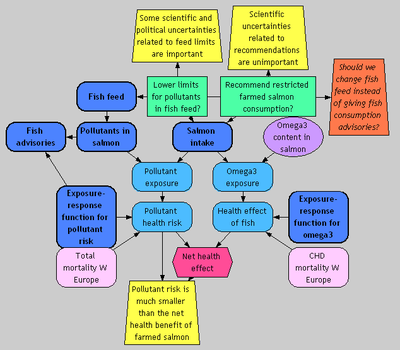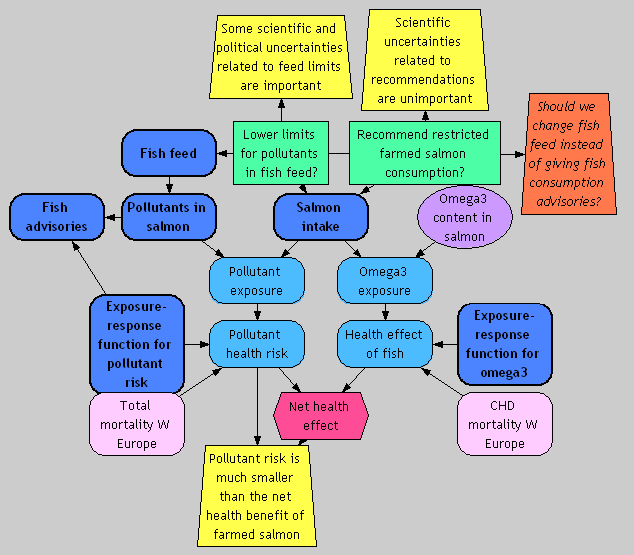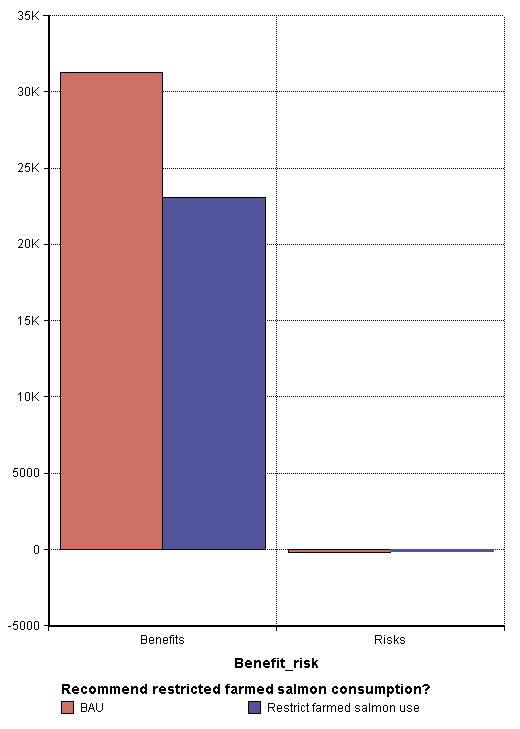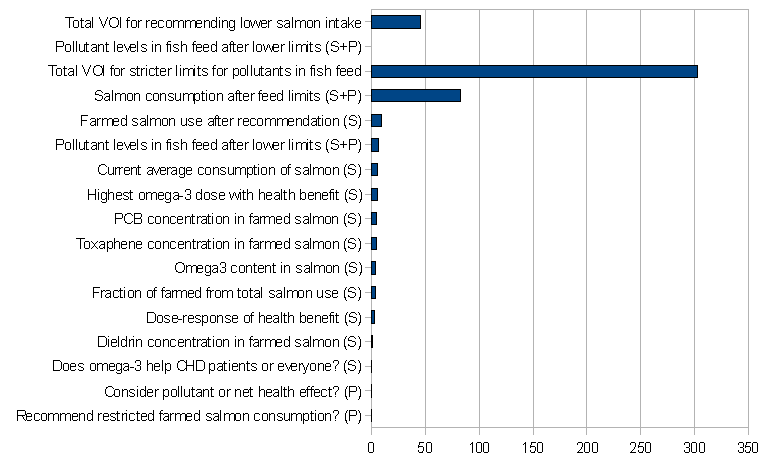Benefit-risk assessment on farmed salmon: Difference between revisions
m (→Purpose) |
(categorised to Finished assessments) |
||
| Line 4: | Line 4: | ||
[[Category:Cancer]] | [[Category:Cancer]] | ||
[[Category:Cardiovascular disease]] | [[Category:Cardiovascular disease]] | ||
{{assessment|moderator=Jouni}} | {{assessment|moderator=Jouni|status=Finished}} | ||
[[op_fi:Hyöty-riskiarviointi viljellystä lohesta]] | [[op_fi:Hyöty-riskiarviointi viljellystä lohesta]] | ||
Revision as of 11:16, 13 March 2015
| Moderator:Jouni (see all) |
|
|
| Upload data
|
| Main message: |
|---|
| Question:
Is the recommendation about not to eat farmed salmon because of its persistent pollutants justifiable based on public health considerations?
|

Scope
Purpose
The purpose of the assessment is to evaluate the recommendation given by Hites et al [1] that people should not eat farmed salmon too often because of the pollutant concentrations. An article by Hites et al.[2] estimated the amount of farmed salmon that would exceed the pollutant risk limit (1 in 100 000 lifetime cancer risk) set by the U.S. EPA [3]. Based on this criteria, Hites concluded that farmed salmon should not be eaten more than one meal (8 oz or 227 g) per month.
Is the recommendation about not to eat farmed salmon because of its persistent pollutants justifiable based on public health considerations?
Boundaries
- Pollutants: Toxaphene, dieldrin, PCB
- Nutrients: Omega-3 fatty acids
- Health impacts:
- Total cancer caused by pollutants
- Cardiovascular deaths and the impact of omega-3 fatty acids
- Population: the population of Western Europe (European Economic Area as of beginning of 2004)
- Current situation (year 2004)
Scenarios
- Recommendation for not to eat farmed salmon too often (yes/no)
- Setting up new stricter regulations about pollutants in fish feed (yes/no)
Intended users
- The primary users are public health authorities and decision-makers involved in giving food recommendations.
- The secondary user group is the general public. Quantitative estimates are offered to increase understanding of the magnitudes of the related issues.
Participants
The assessment is restricted to a group of environmental health researchers. See participant list in Farmed salmon (project).
Definition

Analyses
- Value of information analyses
- Outcome: Net health effect; Decision: Recommend restricted farmed salmon consumption?; Variables tested: all
- Outcome: Net health effect; Decision: Lower limits for pollutants in fish feed?; Variables tested: all
- Importance analyses
- Outcome: Mortality by recommendation; Variables tested: all
- Outcome: Mortality by feed regulation; Variables tested: all
Result
Results
The main results and conclusions have been published by Tuomisto et al.[4]
Figure. Benefits and risks (number of avoided deaths per year) of eating farmed salmon in Western Europe.
Table: Net health impacts (avoided deaths per year) of eating farmed salmon in Western Europe. The results include the health impacts of the total health impact of omega-3 intake from salmon.
| Statistics or fractile | Business as usual | Recommend restrictions | Stricker rules for feed | Both |
| Mean | 31062 | 22929 | 31428 | 23296 |
| SD | 22650 | 17105 | 22842 | 17317 |
| 0.01 | 576 | 404 | 653 | 460 |
| 0.025 | 1782 | 1286 | 1847 | 1356 |
| 0.05 | 3632 | 2697 | 3766 | 2803 |
| 0.25 | 14547 | 10590 | 14780 | 10793 |
| 0.5 (Median) | 25187 | 18504 | 25479 | 18829 |
| 0.75 | 43064 | 31526 | 43628 | 32091 |
| 0.95 | 76141 | 56697 | 77010 | 57393 |
| 0.975 | 88267 | 66397 | 89040 | 67249 |
| 0.99 | 101832 | 79328 | 102202 | 80143 |
Table: Net health impacts (avoided deaths per year) of eating farmed salmon in Western Europe, compared with the business-as-usual scenario. The results include the health impacts of the total health impact of omega-3 intake from salmon.
| Statistics or fractile | Business as usual | Recommend restrictions | Stricter rules for feed | Both |
| Mean | 0 | -8133 | 366 | -7766 |
| SD | 0 | 9703 | 982 | 9637 |
| 0.01 | 0 | -45895 | -2335 | -45557 |
| 0.025 | 0 | -35624 | -1662 | -35171 |
| 0.05 | 0 | -27745 | -1155 | -27041 |
| 0.25 | 0 | -10929 | -60 | -10553 |
| 0.5 (Median) | 0 | -4876 | 264 | -4560 |
| 0.75 | 0 | -1567 | 820 | -1307 |
| 0.95 | 0 | -112 | 2117 | 147 |
| 0.975 | 0 | -10 | 2635 | 459 |
| 0.99 | 0 | 14 | 3180 | 995 |
Figure. Value of information (VOI) calculated as avoided deaths per year in Western Europe. The first two bars are for the decision about recommending restrictions to salmon consumption. No single variable was important enough to gain any VOI; therefore, only the uncertain variable emphasized by Hites[1] is shown. The other bars are for the decision about setting stricter limits for fish feed.
Conclusions
- Pollutant risk is much smaller than the net health benefit of farmed salmon
- Scientific uncertainties related to recommendations are unimportant
- Some scientific and political uncertainties related to feed limits are important
See also
Fish-related assessments:
- Benefit-risk assessment of fish consumption for Beneris
- Benefit-risk assessment of methyl mercury and omega-3 fatty acids in fish
- Benefit-risk assessment on farmed salmon
- On open letter by Vivian Krause: "It does not appear to me that Hites et al. (2004) and Krkosek et al. (2007) were published in SCIENCE on the basis of scientific merit."
References
- ↑ 1.0 1.1 R. A. Hites et al. Global assessment of organic contaminants in farmed salmon. Science, 9 Jan. 2004, p. 226
- ↑ R. A. Hites et al. Global assessment of organic contaminants in farmed salmon. Science, 9 Jan. 2004, p. 226
- ↑ U.S. Environmental Protection Agency: Recommendations for recreational fishing 199X
- ↑ Tuomisto JT, Tuomisto J, Tainio M, Niittynen M, Verkasalo P, Vartiainen T, Kiviranta H, Pekkanen J. Risk-benefit analysis of eating farmed salmon. Science. 2004 Jul 23;305(5683):476-7 Read the article

